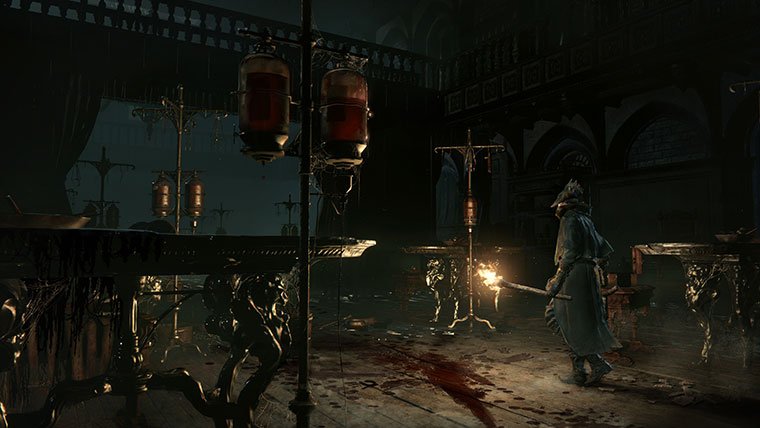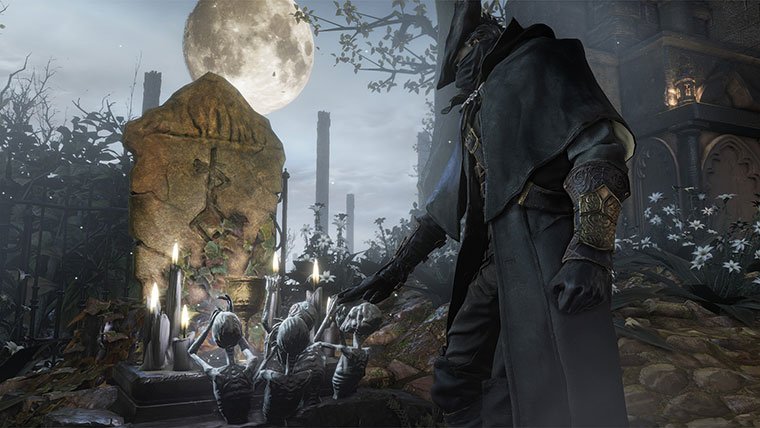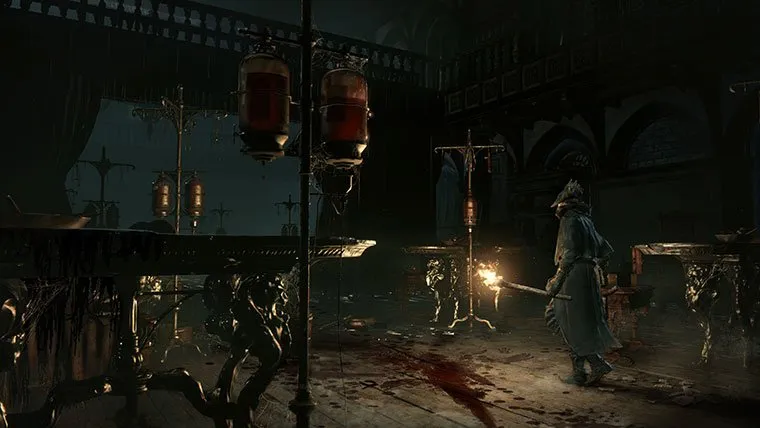From Software and Sony’s Japan Studio teamed up to release Demon’s Souls as a PlayStation 3 exclusive back in 2009. They might not have guessed it at the time, but Demon’s Souls went on to become one of the most beloved PS3 exclusives for Action-RPG players. Incredibly difficult, but rewarding for those that stuck to it — Demon’s Souls introduced PlayStation 3 owners to a different type of action role playing experience. While From Software went on to release Dark Souls and Dark Souls 2 on multiple platforms to critical acclaim, the developer is back on Sony’s team for the PlayStation 4 exclusive Bloodborne. Despite the name shift, Bloodborne feels like a Souls game. There’s a distinct familiarity to the art design, challenge, and gameplay. Souls have been traded for Blood Echoes. Bonfire safe zones have been traded in for lamps. There are actually a lot of call backs to the Souls games that make Bloodborne feel like it might have been misnamed, but it’s also full of refinements that make it feel like the culmination of these recent efforts by From Software.

Like those other games, From Software’s delivery for Bloodborne’s story isn’t exactly clear cut. It’s told sparsely, allowing the world to tell the tale. Though ever so often you’ll get something that unfolds and unravels it during a single 50-60 hour playthrough, even if it’s many times vague and cryptic. You just have to buy in to the fact that you’ve chosen to voluntarily undergo a blood transfusion that’s seemingly gone horribly wrong. Leaving you as a Hunter purging the gothic streets of Yharnam of all sorts of beastly creatures, and also unknowing of whether you’re dreaming or if this is reality. It’s a weird premise, and a single playthrough of the game will certainly have you asking a lot of questions. That should be par for the course for fans of the Souls series. Bloodborne isn’t much better than those games in wrapping things up in a neat little bow. What it is better at, is just about everything else.
Souls players will feel right at home in Bloodborne. It’s still a game about learning from your mistakes, facing new adversaries, learning their patterns and exploring each area for helpful items, secret passages, and boss battles — Bloodborne’s structure is an evolution of these previous games. Those who haven’t played them, it can be a little daunting. From Software doesn’t give you much to go on. You’ll kill enemies and earn “Blood Echoes,” these can then be turned in to level your character… assuming you make it back to the game’s hub world with them. As you become stronger and more skilled in combat, you’ll naturally open new areas to explore, find checkpoints, and continue the betterment of your character.
Bloodborne is a game about learning from your mistakes
Making your way through the Souls games was a sluggish grind. Combat was slow paced, and rewarded players to hide behind their shields and counter enemy attacks. It’s part of the magic of those games though. Since there were so many powerful foes looking to take you out at first sight, it paid to be very careful. That careful traversal translated into a great sense of accomplishment. Bloodborne remembers this, but it also tries to be a much faster game when it comes to combat. While players will still have the opportunity to procure a shield at some point relatively early on in the game, Bloodborne would much rather you use something else. That something else is a Quick Step mechanic, coupled with a dual-function primary weapon and a secondary gun. It changes combat significantly and for the better. Combat is pro-active now. The player feels more agile, and capable of making their own openings to strike first by using Quick Step to get into position or sidestep a possible attack. With all that movement, it’s also easier to take damage as well. This is counter-balanced by being able to recoup some lost HP during a fight, so long as you strike back and aren’t hit again within a specific time window. You can also use your primary weapon in short and long range varieties, giving you room to hit an enemy that might be out of reach otherwise. Furthermore, the secondary firearm weapon can be used to stun enemies, thwarting would be attacks. When you put it all together, From Software gives you all the tools that you need to take a more aggressive approach to combat. Though you never feel forced to play a specific way. There are times when it’s glaringly obvious that a stun move is the solution to your problems. Working wonders to interrupt powerful attacks, where shield baring would have you hoping to block or strafe an enemy.

You’re gonna need to harness all of your available combat options, because Bloodborne is a challenging game that takes away a lot of the hand holding that Dark Souls 2 had. Enemies will always respawn, regardless of how many times you’ve beaten them. Add in the fact that there are less lamps to light, which checkpoint your progress, and some areas can be downright frustrating to beat. There’s more of a reliance on finding shortcuts, opening gates, and activating elevators, then there is on giving you a point to save. Exploration and unlocking shortcuts is only part of the equation, you need to be both proficient enough in combat to earn Blood Echoes, and then, disciplined enough to actually know when its time to spend them on upgrades to level your character, as that will make progression easier as well. Knowing when to bank your echoes is a tricky question. It comes down to whether or not your confident in your ability to pick up this currency once you drop it when you’re killed. And a new twist for Bloodborne is that sometimes enemies will pick up this currency, so you’ll not only need to get back to the area where you died, but defeat the enemy that killed you.

Assuming you do make it back to the game’s hub world called “The Hunter’s Dream,” you can level your character in a number of ways, purchase items, upgrade weapons, manage runes, and store your surplus. Bloodborne differs from the Souls games in that there are fewer weapons in the game, but more ways to customize them, your outfits, and your character’s abilities. Weapons can be fortified with Blood Gems that are earned throughout the game, these have different effects on the stats for the weapon, and can add things like fire or bolt attack to the item. Abilities can be modified through Runes as well. These give overall buffs to the character, like finding more echoes, or having a higher HP or stamina. Outfits also add modifiers to your core stats, giving you better chances against enemies who use specific types of attacks. The Hunter’s Dream hub world also has items for sale. Some cost Echoes, while others use another type of currency called Insight. Insight is another common items found in Bloodborne and must be spent to play in competitive or cooperative modes. Progression, unlocks, and customization are different than what we’ve seen before, perhaps more streamlined than we’ve seen in the past.
Bloodborne feels insurmountable at times, and success is rewarding
Bloodborne has a nice natural progression for the single player campaign. There’s not so much guessing about where to go next. You usually have a pretty good idea of what you’re capable of tackling. Enemies and bosses will both let you know real quick if you’re powerful enough to deal with them, or if you need to tackle something else, level up a bit, or change your loadout. Bloodborne is far from linear, you can tackle areas as you see fit. Bosses signal the end of most areas, and there are quite of few of them in Bloodborne. Every bit as challenging and creative as we’ve seen From Software make in previous games, bosses in Bloodborne continue to feel insurmountable at times, until you get a glimpse at a weakness or pattern to exploit. Fodder enemies are no less difficult or creative. They all have unique attacking patterns that give even short trips the opportunity to turn deadly. Bloodborne’s enemies are the things of nightmares. They might not be “scary,” but they are creatively horrific.

The Souls series has generally fell flat on building a believable world. Bloodborne takes it a step further in creating something that feels not only connected, but cohesive. Not just by joining the areas by secret and unlockable paths, but in the general gothic, plague-ridden theme of the game that persists throughout. Yarnham and its surrounding areas all feel well thought out and in their place, while offering a good deal of variety. Helping to build this cohesive world is the upgrade in visual fidelity that Bloodborne sees over the previous Souls games on consoles. The world is richer, it has more detail than we’ve seen before. Bloodborne puts the PS3 and Xbox 360 versions of those previous games to shame, and is a significant upgrade. It’s also prettier than the PC version of Dark Souls 2, though it doesn’t run anywhere near as smoothly. Frame rate issue do pop up from time to time, and panning the camera can be dizzying. Bloodborne is clearly taking advantage of the powerful PlayStation 4 hardware. It can be a beautiful, beautiful game at times. At others it can seem limited, choking on its own beauty. It’s also got some serious load times. In case you haven’t noticed, these new consoles aren’t the best for loading times, and the many deaths you’ll experience playing Bloodborne are accentuated by 30-40 second loads in some cases. Looking at a screen with only the Bloodborne logo no less.
You’ll die a lot. There’s no avoiding it. But, you can dodge it once in awhile. Summoning AI Hunters, or online companions with the Beckoning Bell can ease some of the pain. Using the bell will search for players in your vicinity that are trying to join a cooperative game, and you’ll be able to tackle bosses or difficult areas as a team. Three players can play cooperatively with one another, and From Software has added the ability to play with friends, circumventing matchmaking by using a password matching system for co-op. NPC characters can also be called in for help, but not in all circumstances. Signs will show the player where they can use the Beckoning Bell to call in AI help. Playing online you’ll also find notes scrawled in key locations by other Bloodborne players that can give you a heads up on a trap or ambush, or just flat-out troll you. Speaking of trolling, you can also jump into other player’s games and fight against them, like the Souls series. At any time you can use the Silencing Blank item to end your competitive or cooperative session and go back to hunting on your own. The idea is to either call for help to beat a boss, enter to help beat a boss, or stop a hunter from reaching a boss.

There’s considerable replay value there in the competitive and cooperative aspects of Bloodborne, and there’s more than enough reason to jump into new game plus after you’ve finished it. Souls games have all warranted a second playthrough for both challenge and discovery, but Bloodborne offers something new in its procedurally generated Chalice Dungeons. The dungeons are full of items, enemies, traps, and of course, bosses. These are also accessed from the Hunter’s Dream hub world, and you’ll need both a Chalice and Ritual Blood to start one. Each Chalice has different tiers and depths of dungeons. The bigger the depth, the more challenging the dungeon. Venturing into these worlds you’ll not only want to beat the bosses to head lower into the dungeon, but inspect the nooks and crannies of each to uncover items that will allow you to perform other Chalice rituals. These dungeons can be played in three player cooperative or competitive play, as well as opened to the public, and customized with rites. More dungeons to conquer is always a good thing if you fall in love with the combat for Bloodborne. You’ll encounter different types of enemies and bosses than you do in the campaign, and my character who was working on new game plus was having a hard time with the depth 3 Chalice Dungeons. The only complaint that I can levy against Chalice Dungeons is that the procedural generation seems thin, and many areas feel like they have identical, slightly tweaked layouts, eventhough enemies will vary. All in all though, this additional content could be something that keeps Hunters in the game long after the story mode has been completed.
The Verdict
It’s safe to assume that not everybody is going to enjoy Bloodborne. It’s such a harsh and unforgiving game that newcomers might be turned off by some of the vagueness in the story and the soul crushing losses that will inevitably occur over its course. Those that are up for the challenge of Bloodborne are going to find a game that plays better, looks better, and has more to keep you occupied than any of the Souls games had. From Software has refined that formula in many spots, and completely overhauled it in others. Leaving us with what is probably the best exclusive to hit the PlayStation 4 since launch, and the best action-RPG to arrive since, well, Dark Souls 2.











Published: Mar 23, 2015 09:00 pm